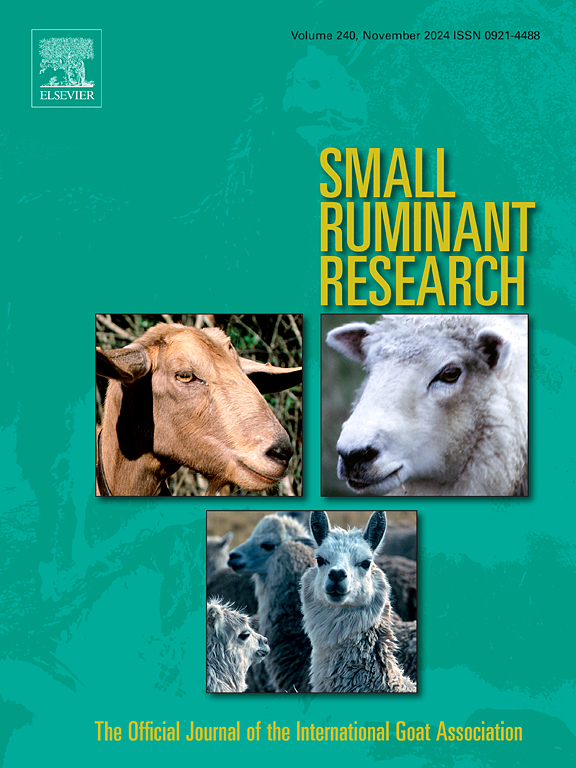南非绵羊品种表型多样性的遗传学基础
IF 1.6
3区 农林科学
Q2 AGRICULTURE, DAIRY & ANIMAL SCIENCE
引用次数: 0
摘要
本研究调查了来自 14 个非洲绵羊品种的 897 只基因分型动物的遗传多样性和形态特征相关基因。这些品种包括黑头波斯羊(BHP)、达马拉羊(DAM)、多尔帕羊(DOR)、肥尾羊(FTT)、卡拉库尔羊(KAR)、肉羊(MMR)、美利奴羊(MER)、纳马夸阿非利加羊(NAM)、佩迪羊(PED)、白多尔帕羊(WDOR)、祖鲁羊(ZUL)、埃塞俄比亚孟兹羊(EMZ)、Ronderib阿非利加羊(RDA)和红马萨伊羊(RMA),其中后三个品种的基因型来自 WIDDE 平台。结果显示,ZUL 的基因组杂合度最低(0.308),MER 的最高(0.352)。基于全基因组 SNP 的 PCA 分析表明,聚类主要是根据预先确定的种群进行的。使用成对的 FST 值和重叠 ROH 分析了尾长、纤维类型、被毛颜色和角的形态特征。被毛颜色相关基因(ASIP、MC1R、TYRP1)位于 FST 值最高的区域附近。在有角表型群体中,在与角发育有关的 HOXD1 基因附近发现了重叠的 ROH。在毛发表型中,发现了两个角蛋白相关基因(KRTAP6-1、LOC101104027)和调节毛发周期的 FGF5。羊毛表型以与羊毛质量有关的 DLX3 为特征。在肥尾表型群体中发现了五个与尾巴生长有关的基因,包括在长肥尾和短肥尾表型的 FST 分析中都发现的 PDGFD。在长肥尾和短瘦尾表型中,与尾部脂肪沉积有关的 BMP2 基因分化程度较高。利用 SNP 基因型,我们明确了各种本土绵羊品种和当地发展起来的绵羊品种之间的系统发育关系,并证实了当地种群中某些与形态特征相关的基因组区域的保存情况。本文章由计算机程序翻译,如有差异,请以英文原文为准。
Genetics underlying phenotypic diversity in South African sheep breeds
This study investigates genetic diversity and morphological trait-associated genes in 897 genotyped animals from 14 African sheep breeds. The breeds include Blackhead Persian (BHP), Damara (DAM), Dorper (DOR), Fat-tail (FTT), Karakul (KAR), Meatmaster (MMR), Merino (MER), Namakwa Afrikaner (NAM), Pedi (PED), White Dorper (WDOR), Zulu (ZUL), Ethiopian Menz (EMZ), Ronderib Afrikaner (RDA), and Red Massai (RMA), with the latter three obtained from the WIDDE platform. Results showed lowest genomic heterozygosity in ZUL (0.308) and highest in MER (0.352). PCA analysis based on genome-wide SNPs revealed clustering mostly according to pre-defined populations. Morphological traits were analysed using pairwise FST values and overlapping ROH for tail length, fibre type, coat colour, and horn presence. Coat colour-related genes (ASIP, MC1R, TYRP1) were near regions with the highest FST values. In the horned phenotype population, overlapping ROH was found near the HOXD1 gene, linked to horn development. For hair phenotypes, two keratin-associated genes (KRTAP6–1, LOC101104027), and FGF5, which regulates the hair cycle, were identified. The wool phenotype featured DLX3, related to wool quality. Five genes associated with tail growth were identified in the fat-tailed phenotype populations, including PDGFD, identified in both FST analyses of long and short fat-tailed phenotypes. High differentiation at the BMP2 gene that is linked to tail fat deposition was noted between long fat-tailed and thin-tailed phenotypes. Using SNP genotypes, we clarified the phylogenetic relationships between various indigenous and locally developed sheep breeds and confirmed the conservation of certain genomic areas associated with morphological traits in local populations.
求助全文
通过发布文献求助,成功后即可免费获取论文全文。
去求助
来源期刊

Small Ruminant Research
农林科学-奶制品与动物科学
CiteScore
3.10
自引率
11.10%
发文量
210
审稿时长
12.5 weeks
期刊介绍:
Small Ruminant Research publishes original, basic and applied research articles, technical notes, and review articles on research relating to goats, sheep, deer, the New World camelids llama, alpaca, vicuna and guanaco, and the Old World camels.
Topics covered include nutrition, physiology, anatomy, genetics, microbiology, ethology, product technology, socio-economics, management, sustainability and environment, veterinary medicine and husbandry engineering.
 求助内容:
求助内容: 应助结果提醒方式:
应助结果提醒方式:


